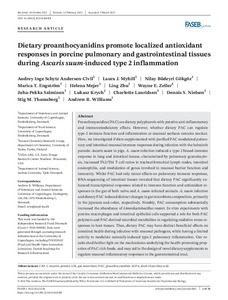Dietary proanthocyanidins promote localized antioxidant responses in porcine pulmonary and gastrointestinal tissues during Ascaris suum‐induced type 2 inflammation
Nielsen Dennis S.; Krych Lukasz; Myhill Laura J.; Salminen Juha-Pekka; Ling Zhu; Williams Andrew R.; Thamsborg Stig M.; Lauridsen Charlotte; Engström Marica T.; Andersen-Civil Audrey Inge Schytz; Mejer Helena; Zeller Wayne E.; Gökgöz Nilay Büdeyri
https://urn.fi/URN:NBN:fi-fe2022081154241
Tiivistelmä
Proanthocyanidins (PAC) are dietary polyphenols with putative anti‐inflammatory and immunomodulatory effects. However, whether dietary PAC can regulate type‐2 immune function and inflammation at mucosal surfaces remains unclear. Here, we investigated if diets supplemented with purified PAC modulated pulmonary and intestinal mucosal immune responses during infection with the helminth parasite Ascaris suum in pigs. A. suum infection induced a type‐2 biased immune response in lung and intestinal tissues, characterized by pulmonary granulocytosis, increased Th2/Th1 T cell ratios in tracheal‐bronchial lymph nodes, intestinal eosinophilia, and modulation of genes involved in mucosal barrier function and immunity. Whilst PAC had only minor effects on pulmonary immune responses, RNA‐sequencing of intestinal tissues revealed that dietary PAC significantly enhanced transcriptional responses related to immune function and antioxidant responses in the gut of both naïve and A. suum‐infected animals. A. suum infection and dietary PAC induced distinct changes in gut microbiota composition, primarily in the jejunum and colon, respectively. Notably, PAC consumption substantially increased the abundance of Limosilactobacillus reuteri. In vitro experiments with porcine macrophages and intestinal epithelial cells supported a role for both PAC polymers and PAC‐derived microbial metabolites in regulating oxidative stress responses in host tissues. Thus, dietary PAC may have distinct beneficial effects on intestinal health during infection with mucosal pathogens, while having a limited activity to modulate naturally‐induced type‐2 pulmonary inflammation. Our results shed further light on the mechanisms underlying the health‐promoting properties of PAC‐rich foods, and may aid in the design of novel dietary supplements to regulate mucosal inflammatory responses in the gastrointestinal tract.
Kokoelmat
- Rinnakkaistallenteet [19207]
